You may remember the Chevy Volt – which was an electric car without the wait – or the anxiety.
It had a small gas-burning engine as well as an electric battery and motors. But unlike other hybrids, the gas engine was almost exclusively an onboard generator that burned gas so the driver didn’t have to stop (and wait) for a charge. The Volt was primarily propelled by its electric motors, just like an electric car – for about 50 miles. That’s about how far it could go on a full charge. But the Volt could go much farther because its gas engine kicked on to replenish the charge as you drove.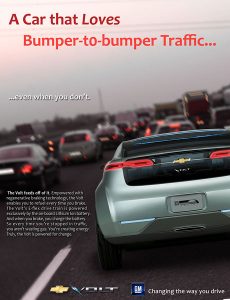
And when you had time for a charge, you could also plug it in to recharge.
It was an EV you could drive like any other vehicle.
The Mitsubishi Outlander Plug-in hybrid works similarly. It can travel on battery power, just like an EV – for about 38 miles. But it doesn’t have to stop for a charge when its battery runs low – because it has a gas engine that keeps you going (and charges the battery, as you go).
When it’s convenient to plug it in, you can.
But no one’s forcing you to.
What It Is
The Outlander is a compact-sized crossover with a standard third row and seating for up to seven. The plug-in variant can go about 38 miles on a full charge – which may be enough range to get where you need to go (and back) and thereby use very little (or even no) gas getting there and back.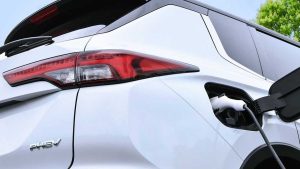
And if not, you can still get there – and back – without having to wait for a charge.
In other words, it’s an electric vehicle that can be driven like any other vehicle.
Like the Volt – except in the shape of a crossover and with room for seven rather than just five.
Prices start at $40,345 for the ES trim, which comes standard with 18 inch wheels, dual zone automatic climate control and a six speaker audio system.
A top-of-the-line Platinum trim stickers for $50,345 and comes standard with two-tone Black Diamond and silver paint, a panorama sunroof, three zone climate control, a premium nine-speaker Bose audio system, heated leather seats and a larger (9 inch) LCD touchscreen. This trim also comes standard with DC fast-charging capability – which is very uncommon among plug-in hybrids.
Other trims can be recharged at home using either “Level 1” (120V) ordinary household-type outlets or “Level II” (240V) dryer-type outlets.
What’s New For 2024
Other than the new Platinum trim, the Outlander plug-in hybrid is unchanged for the new model year.
What’s Good
Own an EV – without the hassles of owning an EV.
Standard third row folds into the floor, minivan-style.
420 miles of range doesn’t cost extra.
What’s Not So Good
Just 38 miles of EV-only range.
Once the charge is depleted – and the engine comes on to keep you going – you’ll be averaging about 26 MPG.
Fast charging capability is limited to the more expensive trims and uses a CHAdeMO charging port, which doesn’t work with some fast chargers.
There’s a a 2.4 liter four cylinder engine under the Outlander PHEV’s hood – similar to the 2.5 liter engine that’s under the hood of the non-hybrid Outlander. The difference is that in addition to sometimes powering the front wheels, it also indirectly powers the rear wheels – by generating the electricity that powers the motors that exclusively turn the rear wheels.
These are entirely electrically powered.
When the 20 kWh battery (the most powerful battery in the class) runs low on charge, the 2.4 liter engine replenishes it so that there is always power enough to keep the rear wheels turning. So long as there’s gas in the tank, the front wheels will keep on turning, too.
You have a total of 420 miles of combined range – amply sufficient to eliminate any anxiety about range. It’s also standard range. Most EVs come with much less range, standard – and more costs thousands extra.
It’s true only 38 miles of the Outlander PHEV’s range is electric-only range – and you might not get that far down the road, depending on how you drive. But the point is you can drive – without planning your drive around waiting for a charge.
It takes less than 5 minutes to fully refuel the Outlander PHEV with gas. It takes longer to recharge the battery – about six hours at home using 240V “Level II” current. But you don’t have to wait six hours – or even 15 minutes – when the Outlander’s battery runs low on charge.
You just keep on driving – and let the engine do the charging.
Combined system output is 248 horsepower, enough to get the plug-in Mitsubishi to 60 in just over 7 seconds.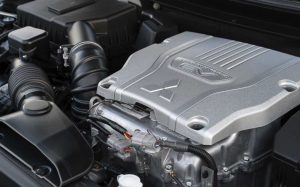
This part-time EV can pull a small (2,000 lbs.) trailer, too.
The government credits this Mitsu with returning 64 MPG “e” – but that does not mean it goes 64 miles-per-gallon. The MPG “e” thing is confusing as well as (arguably) dishonest in that it suggests a much greater efficiency advantage for EVs than for vehicles with engines, by not factoring in efficiency losses at the site of electrical generation – and transmission losses getting the power from the plant to the EV, via the plug.
There is also the implication-impression that the vehicle goes farther per-gallon than it actually does.
And it can be actual – provided you are able to do most of your driving on a fully charged battery – as opposed to using the gas engine to charge up the battery, as you drive. If you’re able to plug in overnight and begin your drive with a fully charged battery – and your trip is within the driving range of a fully charged battery – you can probably exceed “64 MPG e,” by not using any gas to get where you need to go.
But if your drive is longer than the roughly 38 miles this unit can go on a fully charged battery, the 2.4 liter engine will come on – to keep you going – and from that point on, you’ll be getting about 26 MPG (no “e”).
That’s still not bad. It’s better than some. But it’s not 64 MPG – “e” or otherwise.
All trims comes standard with all-wheel-drive, because all trims have an electric motor directly driving each set of wheels (up front, there’s a motor and the 2.4 liter engine powering the wheels).
Mitsubishi calls the system Super All-Wheel-Control.
It’s nice not having to stop – and wait – for a charge. And to be able to drive on a charge, when you have the time to wait for one.
Having options is always nice.
EVs don’t come with those. You drive as far as the charge allows – and then you must wait for a charge. The problem is that it might take more time than you may have, especially if you didn’t plan ahead to have the time to wait. No such problems with the Outlander, which you can just drive – as you would any other car.
No need to feel anxious about how much charge you’ve got left.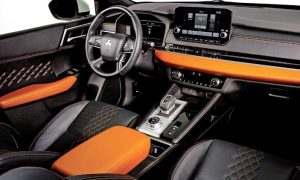
Eventually, you’ll run low . . . on gas. But with about 400 miles of driving range remaining after you’ve run out of charge, you have a long way left to go. And you probably won’t need to stop for gas more than once a week. Plus, it only takes a few minutes to get a full tank of gas. As opposed to a partial (80 percent) charge in maybe 30 minutes or so for an EV’s battery pack.
And even that isn’t very “fast” when you take into account that you’ll likely have to wait that long more than once a week – because the electric car you’re driving probably doesn’t have 400-plus miles of fully charged range to begin with. Compounding that problem is that you’d be starting out with just 20 percent less than whatever its maximum, fully charged range is after spending 30 minutes or so at a “fast” charger – because “fast” chargers limit how much charge they can impart to 80 percent, to avoid harming the battery.
It’s kind of fun to watch the Outlander’s charge remaining indicator go down – because it doesn’t matter. You don’t need to watch it all, in fact – because so long as you’ve got gas in the tank, there’s nothing to worry about.
Other than using more gas – once you run out of charge.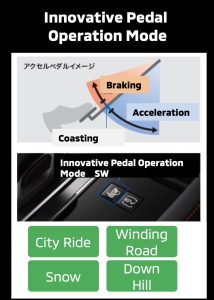
But 26 MPG (average) is about what you’d get out of other crossovers the Outlander’s size – and the Outlander has the “dual fuel” flexibility gas-only crossovers lack.
For people who mostly drive short trips, it can be an EV (rather than a PHEV) in all but acronym.
This Mitsubishi feels electric; it has driver-selectable “one-pedal” operation similar to that found in most purely electric vehicles. You can use the accelerator to go – and to slow. Just lift off the accelerator – and the Outlander decelerates. When in EV mode – and assuming a full charge – it operates nearly silently, just like an EV. But when the gas engine comes on – whether to top-off the battery or to provide extra motive power when accelerating – it doesn’t sound like an EV.
It sounds like it has an engine, which is pleasant – if you like the sound of something happening as you’re accelerating.
But there is no shifting. Like EVs, it has a one-speed direct-drive set-up. Drive is more like Forward.
And so it goes.
The Outlander’s in the same class as other small crossovers such as the Toyota RAV4 and Hyundai Tucson – but it’s a about 3-4 inches longer than they are, so it looks like (and is) a larger vehicle than they are.
It is also styled to look more like an SUV than a crossover – and its looks are backed up by some goods. In addition to the leverage advantage of the dual-electric motor AWD system, there is the advantage of 8.3 inches of standard ground clearance and driver-selectable terrain modes.
Being able to drive over snow is a key factor in being able to get through snow.
Another advantage – one that’s exclusive to the hybrid version of the Outlander – is a third row that stows, as opposed to just folds – greatly increasing the Mitsu’s cargo-carrying space without the hassle of having to physically remove the third row to carve out the space. 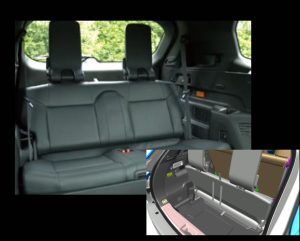
Adding to the storage capacity is a hidden under-the-floor cubby in the rear cargo area that can be used when the third row is up and in place.
Total cargo capacity is 78.5 cubic feet (more than the Toyota RAV4, Hyundai Tucson and other small crossovers in the class).
While the third row’s a tight squeeze for adults, it’s viable for kids and teens – and that makes this 7 passenger-capable compact crossover a viable family vehicle. Other, slightly smaller crossovers such as the RAV4, the Tucson and Honda CR-V don’t offer a third row. 
All trims come standard with a 12.3 inch digital display instrument cluster that includes an EV-esque charge/power gauge to the left of the speedometer and a 1500 watt accessory power point in the cabin, in addition to the usual USB power points.
You can get massaging front seats in the Outlander PHEV. This is a metric of how luxurious non-luxury-brand models are becoming. Go back about five years and try to find a vehicle not made by Mercedes or BMW or Lexus that offered massaging seats.
The Rest
Mitsubishi will offer a Ralliart version of the Outlander PHEV sometime later in 2024, maybe by spring.
This will be a higher-performance version of the Outlander PHEV.
While details weren’t final when this review was written in late December of 2023, the rumor is that Mitsu will goose the output of the hybrid-electric drivetrain to 268 horsepower. A lowered suspension and wheel-and-tire upgrades for improved high-speed handling will also be part of the package, along with cosmetic treatment to set the Ralliart apart from other Outlander PHEVs.
The Bottom Line
If you’re interested in an EV – but not interested in feeling anxious about range – this part-time EV could be the right EV for you.
. . .
If you like what you’ve found here please consider supporting EPautos.
We depend on you to keep the wheels turning!
Our donate button is here.
If you prefer not to use PayPal, our mailing address is:
EPautos
721 Hummingbird Lane SE
Copper Hill, VA 24079
PS: Get an EPautos magnet or sticker or coaster in return for a $20 or more one-time donation or a $10 or more monthly recurring donation. (Please be sure to tell us you want a magnet or sticker or coaster – and also, provide an address, so we know where to mail the thing!)
If you like items like the Keeeeeeev T shirt pictured below, you can find that and more at the EPautos store!






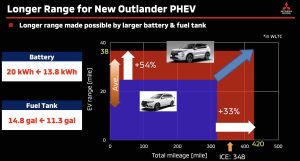
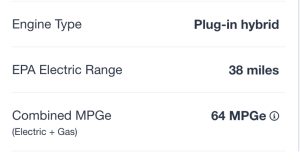

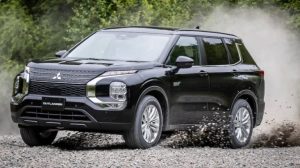
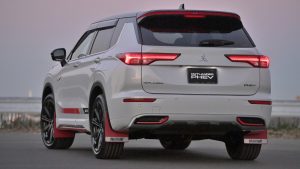






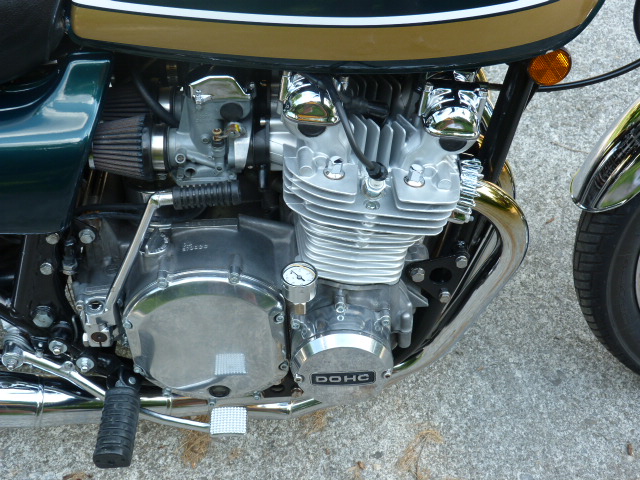
I don’t believe this has the same base engine as the non-hybrid Outlander. The non-hybrid has the Nissan 2.5 (the Outlander is a Rogue is a different set of clothes) while this has the Mitsu 2.4 that powered the previous generation Outlander.
That’s a radical design for a cool SUV.
Remember the photo of Joe Biden driving a Ford truck with the head rest with a center post/stem? It was here at EP autos some time back now.
It’s how you get killed in a rear-end collision. A local farmer probably 44 years ago now lost his life when the single headrest stem went through his head and he died instantly.
That is why there are two post headrests in cars.
Always a problem that needs to be solved.
More dreaded drudgery every doggone day.
Picked up a minty 99 Ford Eddy Bauer Explorer with the magnificent GT40P 302 for $1400. Got 20mpg driving home at 60-75 mph. I’m quite sure I’ll be a lot of gas, money, and smiles ahead in a year or 2 when I get tired of it. That thing will smoke all 4 tires, pull a modest trailer, and go through anything I want it to. I love the interior layout, the buckets and console fit me just right.
$38,600 buys a hell of a lot of gas.
A co worker has the first generation Chevy Volt. It would be ok, if it wasn’t for all the time its in the shop broken……
There are such things as testing laboratories. Concrete testing laboratories count a lot.
Chemistry is what works, elements and all of that nonchalant jazz. Real science really does produce results. Can be deadly, Gaza is one example.
Gotta go with the solid rocket fuel boosters at launch, orbit is where to go.
EV buyers, future owners of millions of white elephants, are also crash test dummies.
Their choice, can’t fix stupid.
Yeah, there’s NO WAY I would ever spend $40,000 on a throw away vehicle like this one. Every one of these vehicles will be rotting and leaching their environmentally friendly chemicals into a landfill in 5 years.
And that’s the point. To limit our choices to shit vs. shit. They will crow from their twisted demon mouths these words, “See, you are free! You may choose from these mandated choices that we have graciously provided!”
I shove those words right back up their asses by continuing to cherish, maintain, and drive my small fleet of reliably functional and cheap to maintain ICE vehicles from decades of the past, and continue to do so even when they decree that I am no longer allowed.
38 miles of range = why bother? Other than to fill the gub’mint mandates. I’d much prefer a beefy V6 version in the same car. All that added complexity for seemingly very little benefit.
I think you are right that the Chevy Volt model was the ideal and they should have iterated on it to make it have better and better range, horsepower, etc. over time. But that is far too logical and practical for Clown World which is why they killed it.
Hybrids make sense if you are concerned with saving a couple gallons of gas per week.
But then I wonder why that type of person would drop $40k on a car.
I had the same thought. $40-$50K is just unfathomable.
The –average– vehicle price in the US is $48,000. What is unfathomable is why vehicles that haven’t made any significant technological leaps and use the same manufacturing process for decades suddenly doubled in price in the past few years. Because… reasons?
Just more ways for them to impoverish and enslave us and it is working because nobody cares or is too dumb now to realize it is happening. The tax cattle experiment is coming along nicely!